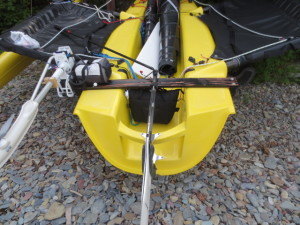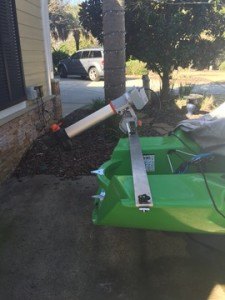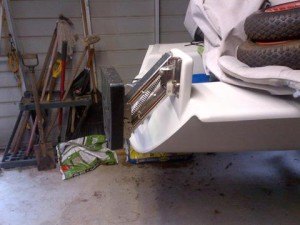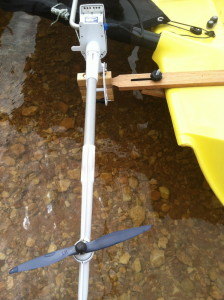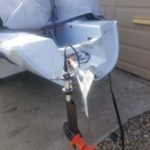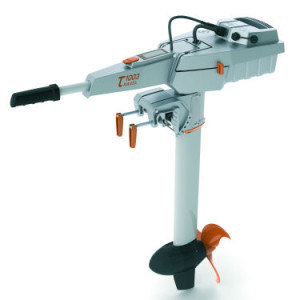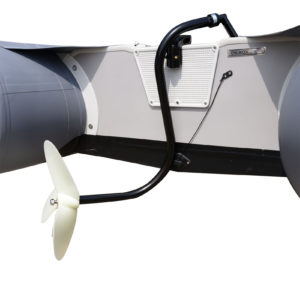Home › Forums › General Weta Stuff › Outboard motors and brackets
- This topic has 12 replies, 4 voices, and was last updated 6 months, 4 weeks ago by
Paul White.
-
CreatorTopic
-
22 May 2020 at 12:20 pm #812
Paul White
Keymaster::How do you fit and store an outboard on a Weta?
Some would say don’t bother as it will always get in the way and in anything above 5 knots of breeze you can move fairly quickly using the sails alone – although sometimes it may help to use the screecher as a “code 0” to keep momentum although you can’t point as high.
However, there may be situations and regulations that require you to have an outboard but if possible, try one of the options using paddles and oars first.
There are two main posts covering brackets and outboards
-
This topic was modified 8 years, 7 months ago by
Paul White.
-
This topic was modified 8 years, 7 months ago by
Paul White.
-
This topic was modified 8 years, 7 months ago by
Paul White.
-
This topic was modified 8 years, 7 months ago by
Paul White.
-
This topic was modified 8 years, 7 months ago by
Paul White.
-
This topic was modified 8 years, 7 months ago by
Paul White.
-
This topic was modified 8 years, 7 months ago by
Paul White.
-
This topic was modified 8 years, 7 months ago by
Paul White.
-
This topic was modified 8 years, 7 months ago by
Paul White.
-
This topic was modified 7 years, 8 months ago by
Paul White.
-
This topic was modified 7 years, 8 months ago by
Paul White.
-
This topic was modified 3 years, 11 months ago by
WetaSydney.
-
This topic was modified 3 years, 11 months ago by
WetaSydney.
-
This topic was modified 3 years, 11 months ago by
WetaSydney.
-
This topic was modified 3 years, 11 months ago by
WetaSydney.
-
This topic was modified 3 years, 11 months ago by
WetaSydney.
-
This topic was modified 3 years, 9 months ago by
Paul White.
-
This topic was modified 2 years, 1 month ago by
Paul White.
-
This topic was modified 2 years, 1 month ago by
Paul White.
-
This topic was modified 2 years, 1 month ago by
Paul White.
-
This topic was modified 2 years, 1 month ago by
Paul White.
-
This topic was modified 8 years, 7 months ago by
-
CreatorTopic
-
AuthorReplies
-
-
25 February 2022 at 5:19 pm #16715::
TEMO-40 Electric Paddle
Winner of the 2021 DAME award, the TEMO-450 electric scull is waterproof (IP67), telescopic (130 to 170 cm) propulsion unit that weighs only 500 kg and attaches to the gunwale with a rowlock accessory. It has a 400-watt motor with 200 watts output and battery life is 42 mins on full power or 80+ mins on 1/2 power. Sold with a cover for easy transport.Video: Oliver Bricout
The Temo attaches to the Weta with a swivelling Oarlock (supplied) which bolts to the gunwale.
It’s too long to fit inside the hatch but it comes with a waterproof case and, according to Oliver, it’s easy to store in the cockpit inside the case while sailing.
Available in Europe, the USA and Australia. More information at https://www.temofrance.com/
-
This reply was modified 2 years, 1 month ago by
Paul White.
-
This reply was modified 2 years, 1 month ago by
Paul White.
-
This reply was modified 1 year, 8 months ago by
Paul White.
-
24 September 2023 at 7:00 pm #19160::
Hello, thank you for sharing this. I am interested in purchasing a TEMO motor and I would like to have more details on fixing the fastener: how to drill, what diameter, what screw or bolt, feedback on solidity, photos .. do you have more information? Is it possible to contact Olivier? Thanks a lot
-
This reply was modified 2 years, 1 month ago by
-
25 February 2022 at 11:23 am #16706::
Brackets
These are options I have seen for brackets:
1. Using a bar (wood or metal) across the stern clamped from gunwale to gunwale with the outboard mounted on a block at the side.2. Stern Bracket
Using a metal bracket mounted on the stern which has been reinforced from the inside using a plate inserted by adding an inspection port on the cockpit side.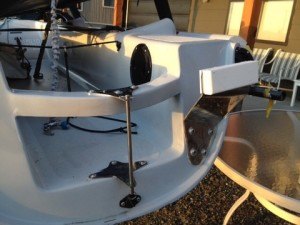
3. Hinged Bracket
Using a hinged bracket attached to a piece of wood inserted into a slot in the stern and then glassed in place – also requiring an inspection port on the cockpit side. Presumably also requiring an inspection port on the cockpit wall to give access inside the hull. The hinge allows the bracket to raise the outboard clear of the water.4. Bolt on bracket
Designed by José Carlos Sánchez for his solo cruising adaption.
I designed this one because it only needs to drill one hole on the Weta´s fiberglass. It can be installed in less than a minute, does not interfere with sailing and does not load the boat too far back. Wood is not a single block, it covers an internal steel frame.
It is worth considering to install an electric outboard if your local conditions allow it. It will reduce pollution and you will not suffer noise and gasoline smell.
Summary
All methods will work although the a bar is easier to fit/remove, can be stowed out of the way when sailing and doesn’t require any holes in the cockpit side. It also means that the outboard is out of the way in most sailing positions if the outboard is not removed while sailing.
-
This reply was modified 2 years, 1 month ago by
Paul White.
-
This reply was modified 2 years, 1 month ago by
Paul White.
-
24 September 2023 at 7:26 pm #19163::
The TEMO comes with the Rowlock fitting which contains screws and bolts for attachment.
https://www.temofrance.com/en_GB/shop/t450-temo-450-104
Rowlock
https://www.temofrance.com/en_GB/shop/sem-1500-rowlock-fitting-9On a Weta I’d recommend using the bolts and installing a curved metal plate under the gunwale to reinforce it.
I have tried to contact Oliver via the French Weta Class forum without success – there’s a thread here.
https://forum.wetaclassefrance.com/viewtopic.php?t=883
-
This reply was modified 2 years, 1 month ago by
-
25 February 2022 at 11:21 am #16701::
Outboards
Probably the most important aspect of using an outboard on a Weta is the weight of the engine and where it can be distributed to have least impact on your sailing experience. Having extra weight on the stern is slow in light winds but of course you can counter that with your body weight.Then there’s the issue of stowing the engine when it’s not in use. The below deck storage compartment has benefits in that the weight of the outboard is then in the centre of the boat and near the water line. However the compartment below deck is not very deep so careful measurement of the engine and compartment is recommended before purchase, if you plan to stow it below.
The standard 6″ hatch is too small for any outboard but Kayak hatches offer various shapes and sizes which can be latched shut securely. The hatch in front of the daggerboard must seal closed because the storage compartment below deck provides buoyancy in a capsize – the boat may not be righted if this is compromised.
If you are storing a petrol outboard below deck you may need to carry an additional fire extinguisher above deck, depending on your local marine regulations.
Lying the outboard in the cockpit is an option but it may get in the way when tacking and is liable to catch on ropes.
Engine options include:
1. Electric paddle

The electric paddle is different from a trolling motor in that it’s designed for propelling small boats rather than just moving quietly after fish. It has a brushless electric motor which outputs 30Wats of power, but unlike a trolling motor, it uses a “model aeroplane” type propeller which is much more efficient for continuous propulsion.
One Weta owner reports: “The EP can move the Weta on calm waters with little to no wind in the 2.8 to 3.0 knot range if you have the main and jib up. Bare pole only the speed drops a couple tenths. The apparent wind created by the propulsion of the EP helps generate the additional speed. Throttling back to the mid-range setting drops the speed by .3 kts so not much of penalty, considering the gain in range. I have yet to run the NIMH battery down to empty and would guess that the furthest I have run on a charge if 4 to 5 miles.”
The manufacturer claims the range is as follows
- Almost 2 hours at High speed
(about 2.5-3.5 mph on many small boats) - Up to 4 hours at Medium speed
- Up to 5 hours at Low speed
Weight:
The motor and battery together weigh less than 16 lbs.- Motor weighs 7.6 lbs.
- NiMH Battery pack weighs 8.1 lb.
- Smart Charger weighs 1.28 lbs.
Size:
- Motor envelope sizes
Short shaft: 7” dia. x 38.5” long
Long shaft: 7” dia. x 43.5” long
Mini shaft: 7” dia. X 33.5” long - Waterproof battery comes in a floating bag 9” x 7” x 6”.
- Smart Charger fits into a 6” x 8” ditty bag.
Minimum battery range:
- At High Setting, the battery will last almost 2 hours.
- At Medium Setting, the battery will last about 4 hours.
- At Low Setting (midway between off and Medium setting) the battery will last 5 hours.
- Recharge time: about 3 hours.
Speed control:
Continuously variable but is marked as follows for reference.- High Setting = 100% output
- Medium Setting = 50% output
- Midway below Medium and Off (not marked) = 33% output
2. Electric outboard motor
There’s a useful buyers guide to Electric outboard motors over 5Kw here and under 5Kw hereSold as a trolling motor for Kayaks ( The 1103 a new more powerful version is now available), the advantage for the Weta is that the drive is separate from the battery and connected by cables. This means you can separate the weight of the battery from the engine which is much better for weight distribution and stowing. Weta owner, Glenn Madere installed the mount following the manufacturer’s diagram for an off-center installation (see p. 47 of the Manual) as if his main hull were a kayak, adjusting the vertical “shaft” as far down as it will go. Between this adjustment and keeping crew weight aft and on the motor side, the prop has enough depth to perform well in up to, say, a foot of chop. The battery is said to be good for 1hr of use.
503 $1699/ 1003 $1999
Revised for 2015 the Torqueedo Travel is sold as a replacement for 1.5 HP (503) and 3HP (1003) Engines but this is a misleading comparison, as a 3hp petrol motor will get many small, lightly loaded craft of the right hull form “on the plane”, and a Torqeedo 1003 won’t. The propeller supplied is not even designed for that sort of speed (it’s rated 9kmph at 790W, or about 6 knots flat out). Where the Torqeedo excels is pushing surprisingly heavy loads (when the 3hp petrol wouldn’t get you on the plane anyway) at up-to-displacement speeds. 4 or 5 knots in a typical 9ft inflatable dinghy, for example.
The acceleration up to those speeds is also impressive, as electric motors (unlike petrol ones) generate full torque from very low revs – there is never a “lag” after twisting the throttle. So the Torqeedo 1003 has lots of low to mid-range push, but not the whizzy top end of a petrol. Unlike “trolling motors” it will be genuinely useful as a main propulsion unit – just not for anything much over 6 knots (12kmph).
- On-board computer with GPS-based calculation of remaining range
- Removable battery and tiller
- Solar rechargeable – including during the voyage
- Stepless forward/reverse drive
- Completely waterproof (IP 67)
- Integrated battery with 320 Wh Li-Ion
- Max speed 9-10 km/h (depending on type of boat, wind and waves)
- Charging time: 7 hrs
- Remote throttle available
Speed in knots (km/h) Range in sm (km) Running time in hours Slow 2.0 (3.7) 12.8 (23.7) 06:20 Half throttle 3.0 (5.5) 6.4 (11.9) 02:08 Full throttle 4.0 (7.4) 2.8 (5.2) 00:42 Torqueedo Travel Model Comparison 503 1003 Input power in watts: 500 1,000 Propulsive power in watts: 220 480 Maximum overall efficiency in %: 44 48 Static thrust in kg / lbs*: 40 68 Integrated Li-Ion battery in Wh: 320 530 Nominal voltage in V: 29.6 29.6 Final charging voltage in V: 33.6 33.6 Total weight in kg / lbs: 12.9kg / 28.4lbs 13.4kg / 24.6lbs Motor weight without battery in kg / lbs: 8.9kg / 19.6lbs 8.9kg / 19.6lbs Weight of integrated battery in kg / lbs: 4.0kg / 8.8lbs 4.5kg / 9.9lbs Shaft Length: 62.5cm / 24.6in 62.5cm/ 24.6in Standard propeller (v = speed in km/h at p = power in watts): v9/p790 v9/p791 Maximum propeller speed in rpm: 700 1,200 Stepless forward/reverse drive: Yes Yes Integrated on-board computer with display: Yes Yes ePropulsion Spirit 1.0
$1930 approx (HQ in Hong Kong, Distributors worldwide)
New Spirit 1.0 Evo is a portable 3HP electric outboard made for dinghies, fishing boats, and sailboats. It features a 1276Wh large integrated lithium battery for long range. The hydrogeneration function recharges the battery while sailing.ePropulsion Spirit 1.0 Evo web page
- kW: 1.0 • Voltage: 40.7 (nominal) • HP: 3
- Battery: Integrated • 1.02 kWh • LiPo (lithium-ion-polymer)
- Running Time: 1 hrs – 4 hrs
- Shaft Length (cm): (XS): 52.5 • (S): 62.5 • (L): 75
- Weight (kg): Motor: 11 • Battery: 8.8 (varies with shaft length and/or tiller)
- Steering: Tiller or Remote, Wireless
- Other: Hyrdrogeneration. Two year limited warranty. As of May 2019 wireless remote control is available
- Country of Manufacture: China
- Price: €1800 – €2136 • $2150 – $2400
ePropulsion Navy 3.0 Evo web page
- kW: 3.0 • Voltage: 46.8 (nominal) • HP: 6
- Battery: Non-Integrated • 3.04 kWh • Li-ion
- Running Time: 1 hrs – 4 hrs
- Shaft Length (cm): (S): 64 • (L): 76.5
- Weight (kg): Motor: 24 • Battery: 31.5 (varies with shaft length and/or tiller)
- Steering: Tiller or Remote, Wireless
- Other: Hydrogeneration. Two year limited warranty, one year on battery. Wide variety of accessories available.
- Country of Manufacture: China
- Price: €2500-€2600 • $2900 – $3050
3. Petrol (4-stroke) motor
$500 approx
The Thai-made Super Chibi uses a reliable 1HP Honda Engine (designed for garden tools) mated to a short drive-shaft and neat integrated petrol tank.
I have seen one used on a Laser (!) which had to sail to yacht racing regulations
Engine Honda GX 25 Maximum Power 1.0 HP. @ 7,000 RPM. Dimensions L660mm x W210mm Cooling System Air Driving system Direct Shaft system ,no Clutch Gear ratio 1:2 Displacement Tonnage ~ 200 Kg. Propellor 3 Blade made from Nylon -66 Resin Fuel tank Capacity 600 cc. Weight 5.5 Kg. (Not including installation set) Consumption Rate ~ 400 CC./Hr. Performance Maximum speed 10 Kmh /5.3 knots
(depending on load, wind, waves)Operation ~ 90 Min 4. Propane Outboard
Price $1000 appprox
The US-made Lehr runs on propane and the cannisters can add to the overall weight.Engine Type Propane-Powered 4 Stroke OHV Horsepower Rating 2.5 hp (1.8 kW) Displacement 4.39 cu in / 72 cc Bore X Stroke 2.12″ x 1.37″ / 54mm x 31.5mm Cylinders 1 Full Throttle RPM Range 4500-5500 RPM Ignition System CDI Ignition Starting System Manual Fuel Propane (110 Octane) Carburetion No Choke / No Priming Lubrication Wet Sump Control System Tiller Handle Trim Positions 5 Gear Shift F-N Gear Ratio 2.08 Shaft Length 15″ Standard Prop 7.25″ x 6″ 3 Blade Aluminium Weight 37.4 lbs / 16.96 kg Fuel Tank Type On Board Twist ‘n Go 16.4 oz Propane Canister Remote (Optional) 11 & 17 lb Composite Tanks Recommended Oil 4 Stroke 10W-30 Engine Oil Capacity 0.37 US qt (0.35L) Warranty 3 Year Limited Warranty C.A.R.B. Rating 3 Star Ultra Low Range 16.4 oz Camping Bottle – @3000RPM – 2.5 hrs, @5000RPM – 1 hr 5. Weed-wacker conversion
Some people realised you could get a crude but effective “outboard” by putting a propeller on the end of a string trimmer (aka “weed-whip”, “whipper-snipper”, “weed-whacker”, “weed eater”, “strimmer”).
There’s now a few conversion kits available that come as a complete unit or you can DIY with a donor unit
Small Outboard Motor – 1.2 HP
Cost: $250 with a 2-Cycle Motor and $325 with a 4-Cycle Motor
Conversion Kit – for those who want to do-it-yourself: $100.The Kit does not include the weedeater, which can be purchased from your local hardware store. Fabricated from a Straight Shaft – attachment capable (Split Shaft) Weed Eater. Both 2 cycle and 4 cycle units are available.
Performance: Weight 13.2 lbs
Speed: Tested with a two person Kayak, West Marine’s Water Tender 9.4, Walker Bay, and a Sevylor Fish Hunter. They all ran between 4.0 to 5.5 Knots loaded with one 165 lbs person, swinger ice chest with 6 pack, fishing pole, tackle box, and oars6. Hand Cranked Outboard.
Originally developed in the 60s, they are now being produced in China and offer a low-tech, quiet propulsion solution – although perhaps oars or a paddle might give you a more efficient method of propulsion for long periods. It might also make be suitable for conversion to power from an electric drill.
Available in UK (£125.00) Germany (EUR 149), Australia (AU$169) under the Freewheeling brand and the USA ($112) as Bris.
The bracket does look a bit flimsy and there’s no hinge to allow it to kick up if you hit anything.In the video below, it shows how flimsy then turning handle is but also how you can improve it substantially with an electric drill. Another video testing the speed and battery life here.
Conclusion
From the options above, you can see that the petrol outboard has the best power to weight ratio and highest top speed – although there are all the issues of pollution, noise and transporting a flammable liquid.The electric motors may not have the top speed of a petrol or propane motor so they won’t get you planing – but they produce thrust at very low speeds and can output a steady power for reasonably long periods. The electric motors can be disassembled allowing you to stow components below deck and some can separate the battery entirely from the drive unit using cables for better weight distribution.
-
This reply was modified 2 years, 1 month ago by
Paul White.
-
This reply was modified 2 years, 1 month ago by
Paul White.
-
This reply was modified 2 years, 1 month ago by
Paul White.
-
This reply was modified 1 year, 7 months ago by
Paul White.
-
This reply was modified 1 year, 7 months ago by
Paul White.
- Almost 2 hours at High speed
-
4 October 2016 at 12:35 pm #1495
-
20 October 2015 at 8:58 pm #1246
-
20 October 2015 at 10:23 pm #1247::
Hi Glenn
I’m not sure since that was a photo from the Yahoo Weta Forums – but I suspect it would be stainless steel as aluminium would need to be pretty thick to be able to take the weight of an engine and probably would have to be welded to accept the bends in the plate shown in the photo.
You might be interested in this universal bracket solution http://www.v-lock.com which looks as if it doesn’t require a backing plate as the load is spread over the surface it’s attached to.
You’d then be able to mount an angled motor bracket to it or a lifting version here.
You could also use stainless toggle bolts to anchor you fitting to the stern without having make a hole in the cockpit to add a backing plate.
The mounting boards tend to be either hardwood or polyurethane.
This bracket on eBay may be a good cheap alternative.
Hope this helps
Paul
-
This reply was modified 8 years, 6 months ago by
Paul White.
-
This reply was modified 8 years, 6 months ago by
-
-
13 September 2015 at 10:27 pm #1145
-
12 September 2015 at 6:25 pm #1131::
Hello there!
I recently became a Weta family member (bought Weta 424) and read this topic with high interest! In Belgium we have strong currents at sea. I have allready build a motor mount for my Weta to be able to go out and return safely. Unfortunately I’m not sure how much hp I should choose to be able to return to the harbor quite fast ,even with strong currents, but also avoiding crossing the legal max. 20km/h limit. Anyone has an idea of the speed output of a 2,5hp and 3,5hp on a Weta? These are very interesting because of their low weight (17kg). All tips are welcome!
Greetings,
Laurent
-
12 September 2015 at 10:10 pm #1132::
Hi Laurent
I don’t know which harbour you use, but according to this research data, the current at Zebrugge is around 4 Knots.
20 Kmh is equivalent to 10.7 knots but there are so many variables you can’t say exactly what speed you’d get. Not forgetting that you can use the sails to supplement the output of the outboard. If there is more than (say) 8 knots of breeze you’d probably go as fast with the sails and no outboard and of course a small boat like the Weta can hug the shore to get out of the current.
According to this test, the Torqueedo would give you a speed of around 6 knots as shown here.
A 2.5hp petrol engine would be faster and could allow the boat to plane – the little Super Chibe 1HP motor would give you around 3-4 knots – depending on wind/waves. A 2.5 engine should be good for about 5-6 knots. There’s a test on a small boat here which gives speeds for different outboards.
Use a GPS or a GPS App on a smartphone like iRegatta to check your speed.
-
This reply was modified 8 years, 7 months ago by
Paul White.
-
This reply was modified 8 years, 7 months ago by
Paul White.
-
This reply was modified 8 years, 7 months ago by
Paul White.
-
This reply was modified 8 years, 7 months ago by
-
13 September 2015 at 6:10 am #1138
-
-
-
AuthorReplies
- You must be logged in to reply to this topic.




